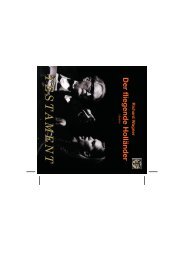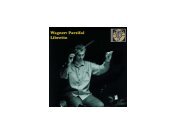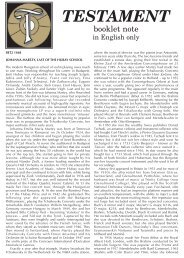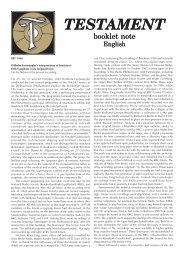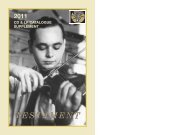TESTAMENT
TESTAMENT
TESTAMENT
Create successful ePaper yourself
Turn your PDF publications into a flip-book with our unique Google optimized e-Paper software.
SBT 1402<br />
Margherita Grandi: the greatest voice I ever heard<br />
Asked the direct question, which was the greatest voice he<br />
had ever heard in an opera house, the distinguished<br />
connoisseur Desmond Shawe-Taylor responded,<br />
unhesitatingly, “Margherita Grandi... the Glyndebourne<br />
performances before the war. She was sublime.”<br />
Shawe-Taylor was not alone in this judgment. Grove’s<br />
Dictionary commented: “She was incomparable.” In<br />
Opera on Record (edited Alan Blyth, 1979), Lord<br />
Harewood writes of her Don Carlo recording: “Margherita<br />
Grandi, with big-scale phrasing and pulsating tone, sings<br />
the music thrillingly.” Harold Rosenthal, in his Concise<br />
Oxford Dictionary of Opera (1964), summarises her as:<br />
“One of the few modern singers of the ‘grand style’, whose<br />
Tosca and Lady Macbeth were sung and acted with a<br />
sweep and conviction rare today.” And John Steane in The<br />
Grand Tradition says: “It was to the ears of this post-war<br />
generation, longing to hear again singing that could sweep<br />
regally and soar with international authority, that the few<br />
records of Margherita Grandi were so welcome. The arias<br />
from Macbeth were directly in the grand tradition, noble<br />
and commanding, rich-voiced and dramatic.”<br />
A great difficulty in outlining her life and work is the<br />
lack of reliable sources. So the pioneering work of Barbara<br />
and Findlay MacKenzie, Michael Bott and Douglas Hassall<br />
must be acknowledged and welcomed by all subsequent<br />
writers, and I have been fortunate to be helped by Grandi’s<br />
relatives in Milan, Tasmania and New South Wales.<br />
The official records show that Grandi was born<br />
Margaret Gard, second of four daughters of Bernard and<br />
Catherine (née Ryan) Gard, at Harwood Island in the<br />
Clarence River district of New South Wales in Australia on<br />
10 October 1892. Her father “Barney”, an engine driver,<br />
sang and played the concertina. The standard reference<br />
works on opera give differing years for her date of birth,<br />
and her name, and assert that she was born in another<br />
state, Tasmania. In fact, her family did move to Hobart in<br />
October 1903, and it was from that city that she departed<br />
on Regatta Day in February 1910, aged 17, to study in<br />
Europe. Her passage to Europe, together with her board in<br />
Paris and lessons, were funded by a farewell concert at the<br />
Grand Empire Theatre. The local newspaper gave an early<br />
description of her vocal capabilities: “Miss Gard has a<br />
beautiful voice, a voice of exquisite timbre and wonderful<br />
range.” A few months later, another piece reported that<br />
Maggie Gard had impressed Madame Marchesi in Paris,<br />
but that she needed further funding.<br />
In Paris, she is said to have taken lessons with the<br />
legendary Polish tenor Jean de Reszke. Then, in London,<br />
she studied at the Royal College of Music from September<br />
1912, winning an Open Scholarship (against several<br />
hundred other applicants) worth £400 in February 1914. In<br />
November that year, it has been asserted that she made her<br />
<strong>TESTAMENT</strong><br />
booklet note<br />
English<br />
début as a mezzo at the Opéra-Comique in Paris,<br />
appearing in Massenet’s Werther, and singing Carmen in<br />
that same season. At some stage, she stayed as a guest and<br />
studied with another great singer in Paris, Emma Calvé.<br />
The First World War may have disrupted her career, but<br />
having completed her studies at the Royal College in 1917,<br />
she picked it up again at the cessation of hostilities in<br />
France. Perhaps most significantly, she created the title role<br />
in Amadis, in the April 1922 première of Massenet’s opera<br />
at Monte-Carlo, appearing under the name Djemma Vecla,<br />
an anagram of Calvé. It has been suggested that she<br />
appeared at other times under other names.<br />
Bott thinks it “very, very unlikely“ that she sang mezzo<br />
roles in Paris – but she must have done something to earn<br />
a living before her marriage. Margaret Gard married the<br />
Italian stage designer, Giovanni Grandi, in the mid-1920s,<br />
making her home in Milan, and thus Margherita Grandi<br />
was born. They had a daughter, Patricia, born in 1928.<br />
Initially a portrait and landscape artist, Giovanni had<br />
become a leading opera designer and scenery painter, first<br />
in St. Petersburg, then from 1922 at La Scala, Milan, his<br />
début there fittingly with Boris Godunov. In the latter part<br />
of the 1920s, Giovanni went briefly, with Margherita, to be<br />
Artistic Director of the San Francisco Opera.<br />
It was after her marriage that she made the decisive<br />
vocal change – from lyric mezzo to dramatic soprano –<br />
making her well-received début at the age of 40 in Italy as<br />
Aida at the Teatro Carcano in Rome in October 1932 (and<br />
announced initially as Margherita Stralia). This new<br />
direction was achieved with the help of the great Italian<br />
soprano and teacher Giannina Russ in Milan. After<br />
appearances as Margherita in Boito’s Mefistofele and<br />
Verdi’s Aida in other Italian cities, Grandi joined the<br />
chorus of La Scala, touring the Netherlands and Egypt,<br />
where she gave four performances as Aida with fellow-<br />
Australian John Brownlee as Amonasro.<br />
Her major break as a dramatic soprano came when she<br />
replaced the prominent Italian, Lina Bruna Rasa, at short<br />
notice as Elena in Mefistofele at La Scala on 11 May 1934<br />
(with Maria Caniglia and Ezio Pinza). This success led to<br />
other major dramatic roles in a wide range of Italian cities<br />
– Tosca and Leonora (in Il trovatore) in addition to Aida<br />
and Mefistofele. In 1936, she returned to Rome, this time<br />
at the Teatro Reale (in Mefistofele with Pinza, conducted<br />
by Serafin), followed by Amelia in Simon Boccanegra. The<br />
following year, she toured South America with Lauri-Volpi,<br />
giving Trovatore and Aida in Rio de Janeiro and Tosca in<br />
São Paulo. She gave her first Desdemona in 1937 (with<br />
Francesco Merli as the Moor) in Verdi’s Otello – at Genoa,<br />
then Trieste, Brescia and Parma (with Pertile) – and<br />
Elisabetta in Don Carlo in Venice opposite the American<br />
tenor Francesco Valentino. She sang in Beethoven’s Missa<br />
solemnis in Trieste under Felix Weingartner and gave<br />
open-air concert performances – Aida in Milan with Gigli,<br />
and Mefistofele in Naples with De Angelis – also
oadcasting frequently for Italian Radio.<br />
Still she had not been taken up by the leading opera<br />
houses outside of Italy, but John Christie, founder of<br />
Glyndebourne Opera, must have heard her and been<br />
impressed, booking her to be his Lady Macbeth in 1939<br />
under Fritz Busch. As Michael Bott notes: “Few sopranos<br />
have the vocal armoury to tackle the enormous difficulties<br />
of Lady Macbeth, a role which demands tremendous vocal<br />
agility and ranges from a low B to the pianissimo D flat of<br />
the famous sleepwalking scene… with substantial vocal<br />
athletics including powerful chest tones, trills in all<br />
registers and two octave runs.”<br />
It was this role that established Grandi’s reputation<br />
internationally. Astonishingly, Verdi’s Macbeth had not<br />
been performed prior to 1938 in England – but these ten<br />
performances were a revelation and a triumph for Grandi.<br />
“Anyone who heard Margherita Grandi sing [“Vieni,<br />
t’affretta”] at Glyndebourne or Edinburgh knows that it<br />
can, with its cabaletta... produce an effect of tigerish<br />
ferocity, and it is not unreasonable to assume that this is<br />
what Verdi had in mind and could obtain in his own day,”<br />
wrote Lord Harewood in his new edition of Kobbé in<br />
1954. The Sunday Times noted that “she is magnificently<br />
voiced; it was thrilling to hear those notes… rolling out<br />
with such power and freedom”, and The Observer<br />
commented that she was “the prima donna that appears<br />
only in the dreams of conductor and producer”.<br />
In more normal times, she would have gone on to<br />
become a great international star but the Second World<br />
War loomed. Initially she was sent to a camp at Avellino,<br />
near Naples, but her husband retrieved her and she<br />
retreated to the Italian Alps near Bergamo for the duration,<br />
only emerging occasionally, most notably taking the lead<br />
role in the Italian première of Richard Strauss’s Friedenstag<br />
in Venice in January 1940, and as Ottavia in Monteverdi’s<br />
L’incoronazione di Poppea in Rome in April 1943 under<br />
Serafin. In the mountains she is said to have actively<br />
supported the partisans, helping to smuggle Allied airmen<br />
to safety in Switzerland.<br />
This enforced break was particularly disastrous for her.<br />
In 1939 she was still in her prime at 47 years old, but by<br />
the end of the war she was already 53 (late for a dramatic<br />
soprano) and would soon begin to decline vocally.<br />
However, she did pick up her career again in 1945, reemerging<br />
in Verdi’s Requiem under Serafin at the Teatro<br />
Lirico (the temporary home of La Scala) in Milan in June,<br />
then in La Gioconda (with Stignani and Gigli) in July 1946<br />
in Rome, opening Verona Festival’s first post-war season in<br />
August in Aida.<br />
Quite soon she came back to Britain, the scene of her<br />
pre-war triumph as Lady Macbeth, repeating that success<br />
with Glyndebourne Opera when they opened the first<br />
Edinburgh Festival in 1947. There were nine performances<br />
of Macbeth between 25 August and 13 September, and it<br />
was the broadcast of that production on 27 August that<br />
<strong>TESTAMENT</strong><br />
booklet note<br />
English<br />
forms the largest part of this new CD. After Edinburgh, she<br />
sang Senta in a BBC broadcast of Wagner’s The Flying<br />
Dutchman, then returned to Italy, giving Verdi’s Requiem<br />
again under Serafin, this time at the Palazzo Ducale in<br />
Genoa.<br />
She also sang with the highly-regarded New London<br />
Opera Company at the Stoll and Cambridge Theatres in<br />
London between 1946 and 1949 (Donna Anna in Don<br />
Giovanni and Tosca), her husband Giovanni with her as<br />
director and designer. In the latter year she returned to the<br />
Edinburgh Festival with Glyndebourne Opera as Amelia in<br />
Un ballo in maschera under Gui, a role she shared with<br />
Ljuba Welitsch.<br />
She also finally made her Covent Garden début in<br />
September, creating the role of Diana in Bliss’s The<br />
Olympians. There, soon after, she gave five performances<br />
of Il trovatore, and her stage career ended at Covent<br />
Garden on 27 November 1951 as Tosca. Her husband,<br />
Giovanni, retired as director of scenic design at La Scala<br />
two years later. Margherita Grandi died in Milan in 1972.<br />
Considering her stature, Grandi made a pitifully small<br />
number of commercial recordings – her most famous<br />
scenes as Lady Macbeth, recorded in 1947 and 1948 with<br />
the Royal Philharmonic Orchestra under Beecham,<br />
Elisabetta’s aria from Don Carlo (also with the RPO, under<br />
Erede), and “Pace, pace” from La forza del destino<br />
(unfortunately destroyed) – these all for HMV. For Decca,<br />
she recorded under Beecham the role of Giulietta in his<br />
complete Tales of Hoffmann, the soundtrack to Michael<br />
Powell and Emeric Pressburger’s 1947 film (which starred<br />
Robert Helpmann, Moira Shearer and Frederick Ashton).<br />
All her other surviving performances are from late in<br />
her career, derived from radio broadcasts and rare ‘private<br />
recordings’ – perhaps there are more still to be discovered?<br />
For years collectors and connoisseurs have sought out<br />
individual recordings by Margherita Grandi. Here, for the<br />
first time, is a whole CD devoted to her ravishing artistry –<br />
a unique opportunity for a new generation of singers and<br />
opera-lovers to discover her.<br />
Roger Neill, 2006




